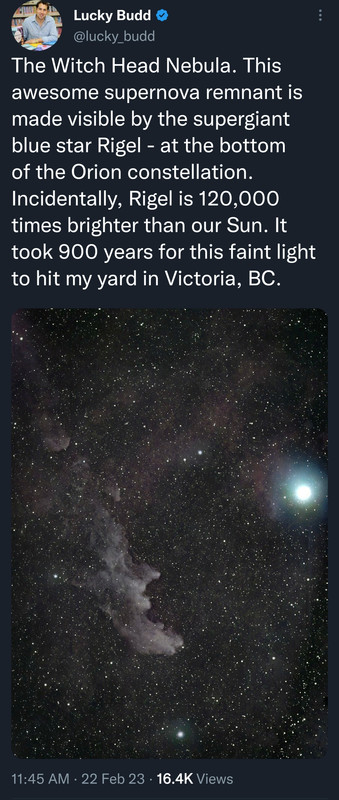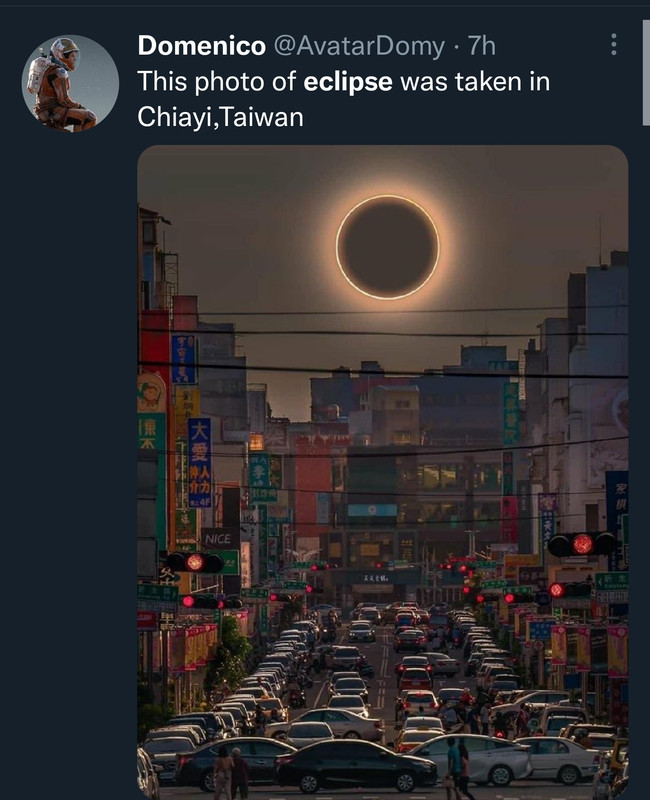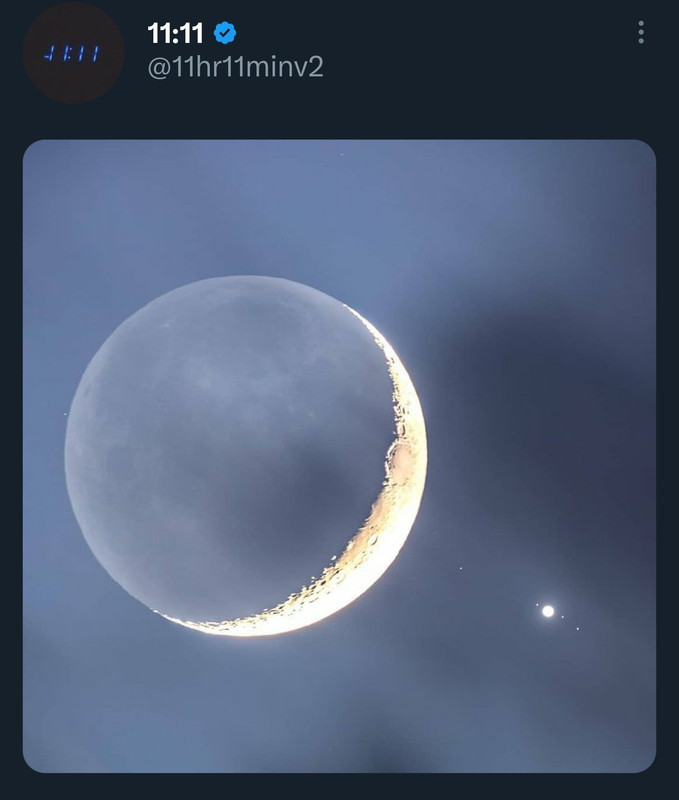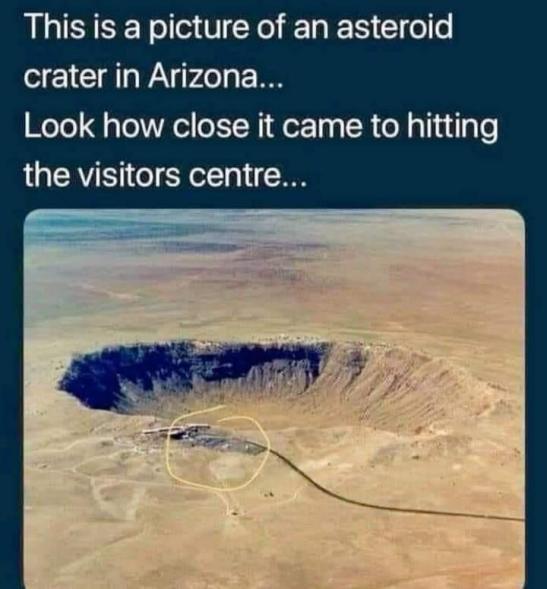-
SCAM WARNING! See how this scam works in Classifieds.
You are using an out of date browser. It may not display this or other websites correctly.
You should upgrade or use an alternative browser.
You should upgrade or use an alternative browser.
I just saw the moon
- Thread starter TheMadDabber
- Start date
CrazyDiamond
HAL is a StarChild
In the heart of the Rosette Nebula lies a bright cluster of stars that lights up the nebula. The stars of NGC 2244 formed from the surrounding gas only a few million years ago. The featured image taken in mid-January using multiple exposures and very specific colors of Sulfur (shaded red), Hydrogen (green), and Oxygen (blue), captures the central region in tremendous detail. A hot wind of particles streams away from the cluster stars and contributes to an already complex menagerie of gas and dust filaments while slowly evacuating the cluster center. The Rosette Nebula's center measures about 50 light-years across, lies about 5,200 light-years away, and is visible with binoculars towards the constellation of the Unicorn (Monoceros).

Imagine traveling to a star about 100 times as massive as our Sun, a million times more luminous, and with 30 times the surface temperature. Such stars exist, and some are known as Wolf Rayet (WR) stars, named after French astronomers Charles Wolf and Georges Rayet. The central star in this image is WR 40 which is located toward the constellation of Carina. Stars like WR 40 live fast and die young in comparison with the Sun. They quickly exhaust their core hydrogen supply, move on to fusing heavier core elements, and expand while ejecting their outer layers via high stellar winds. In this case, the central star WR 40 ejects the atmosphere at a speed of nearly 100 kilometers per second, and these outer layers have become the expanding oval-shaped nebula RCW 58.
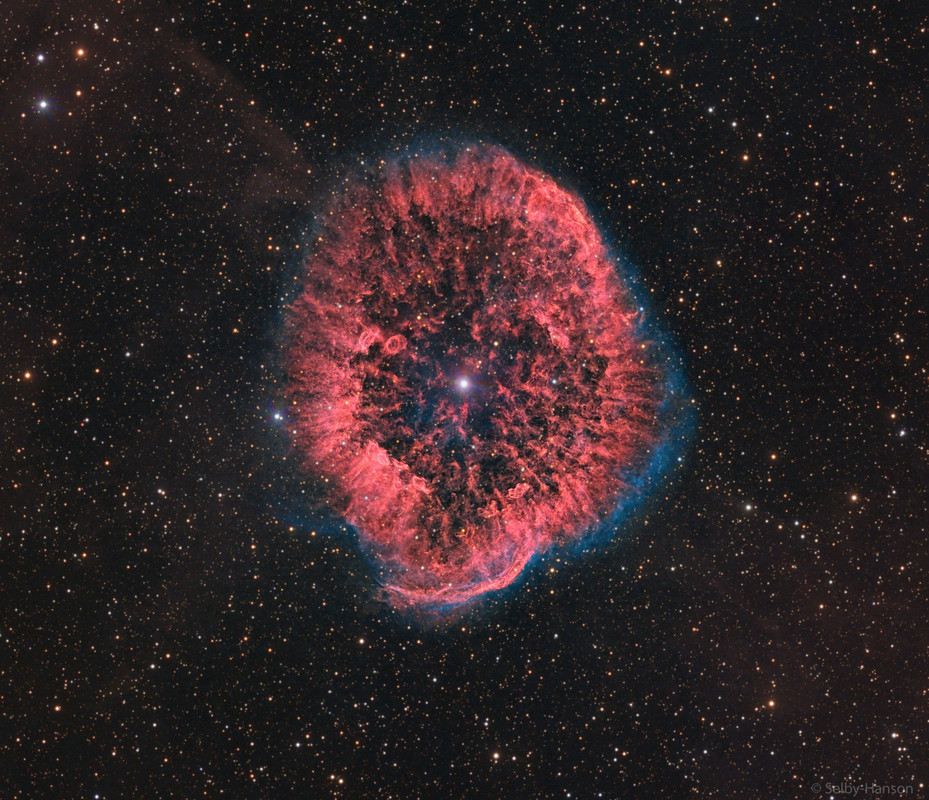
Fading as it races across planet Earth's northern skies comet C/2022 E3 (ZTF) shares this telescopic frame with comet C/2022 U2 (ATLAS). Captured on the night of February 6 from a garden observatory in Germany's Bavarian Forest, the starry field of view toward the constellation Auriga spans about 2.5 degrees. Discovered by sky survey projects in 2022 (the Zwicky Transient Facility and the Asteroid Terrestrial-impact Last Alert System) these long-period comets are outbound, reaching perihelion just last month. The much fainter comet ATLAS made its closest approach to our fair planet on January 29 at a distance of about 4.6 light-minutes, compared to a mere 2.4 light-minutes for comet ZTF on February 2. This comet ATLAS lacks the well-developed tails of the formerly naked-eye comet ZTF. But both comets sport greenish tinted comas, emission from diatomic carbon molecules fluorescing in sunlight.
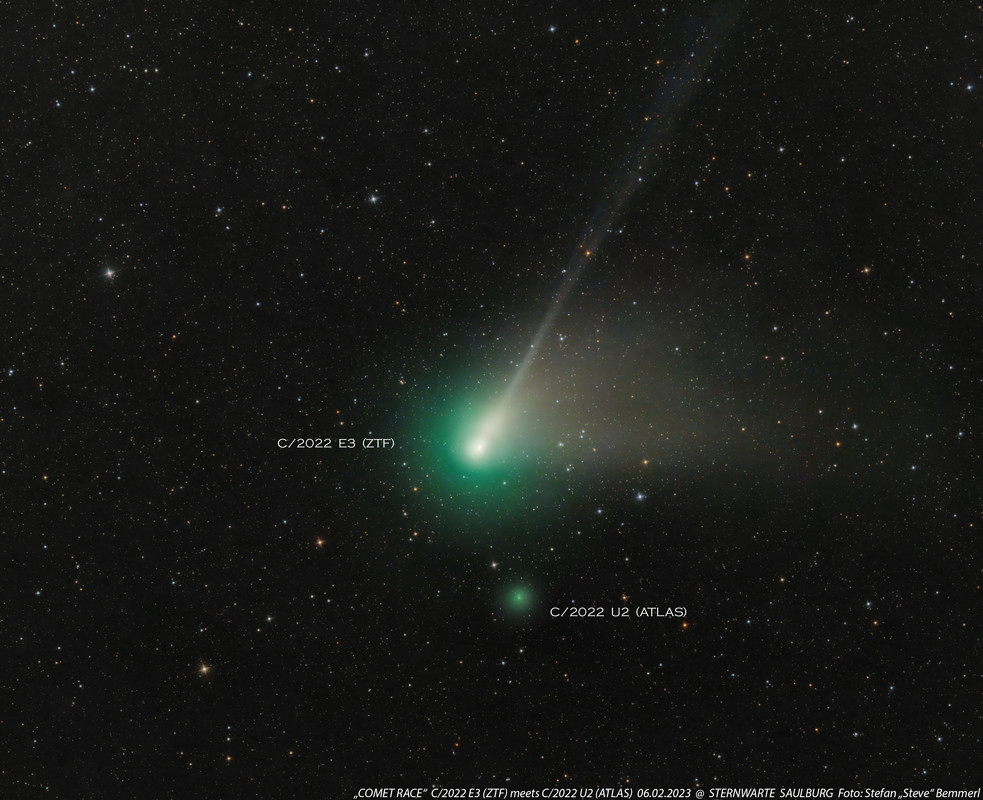
A mere 56 million light-years distant toward the southern constellation Fornax, NGC 1365 is an enormous barred spiral galaxy about 200,000 light-years in diameter. That's twice the size of our own barred spiral Milky Way. This sharp image from the James Webb Space Telescope's Mid-Infrared Instrument (MIRI) reveals stunning details of this magnificent spiral in infrared light. Webb's field of view stretches about 60,000 light-years across NGC 1365, exploring the galaxy's core and bright newborn star clusters. The intricate network of dusty filaments and bubbles is created by young stars along spiral arms winding from the galaxy's central bar. Astronomers suspect the gravity field of NGC 1365's bar plays a crucial role in the galaxy's evolution, funneling gas and dust into a star-forming maelstrom and ultimately feeding material into the active galaxy's central, supermassive black hole.
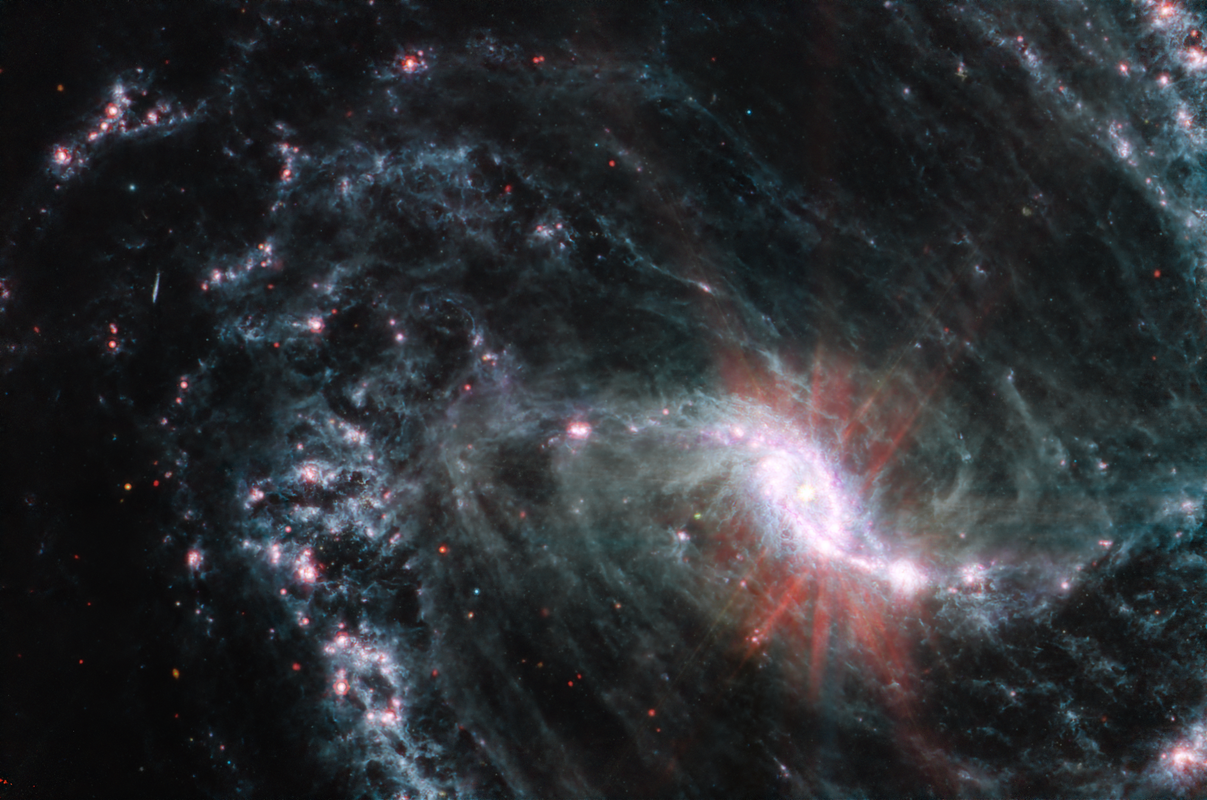
Is this really the famous Pleiades star cluster? Known for its iconic blue stars, the Pleiades is shown here in infrared light where the surrounding dust outshines the stars. Here three infrared colors have been mapped into visual colors (R=24, G=12, B=4.6 microns). The base images were taken by NASA's orbiting Wide Field Infrared Survey Explorer (WISE) spacecraft. Cataloged as M45 and nicknamed the Seven Sisters, the Pleiades star cluster is by chance situated in a passing dust cloud. The light and winds from the massive Pleiades stars preferentially repel smaller dust particles, causing the dust to become stratified into filaments, as seen. The featured image spans about 20 light years at the distance of the Pleiades, which lies about 450 light years distant toward the constellation of the Bull (Taurus).

Our Sun is becoming a busy place. Only two years ago, the Sun was emerging from a solar minimum so quiet that months would go by without even a single sunspot. In contrast, already this year and well ahead of schedule, our Sun is unusually active, already nearing solar activity levels seen a decade ago during the last solar maximum. Our increasingly active Sun was captured two weeks ago sporting numerous interesting features. The image was recorded in a single color of light called Hydrogen Alpha, color-inverted, and false colored. Spicules carpet much of the Sun's face. The brightening towards the Sun's edges is caused by increased absorption of relatively cool solar gas and called limb darkening. Just outside the Sun's disk, several scintillating prominences protrude, while prominences on the Sun's face are known as filaments and show as light streaks. Magnetically tangled active regions are both dark and light and contain cool sunspots. As our Sun's magnetic field winds toward solar maximum over the next few years, whether the Sun's high activity will continue to increase is unknown.
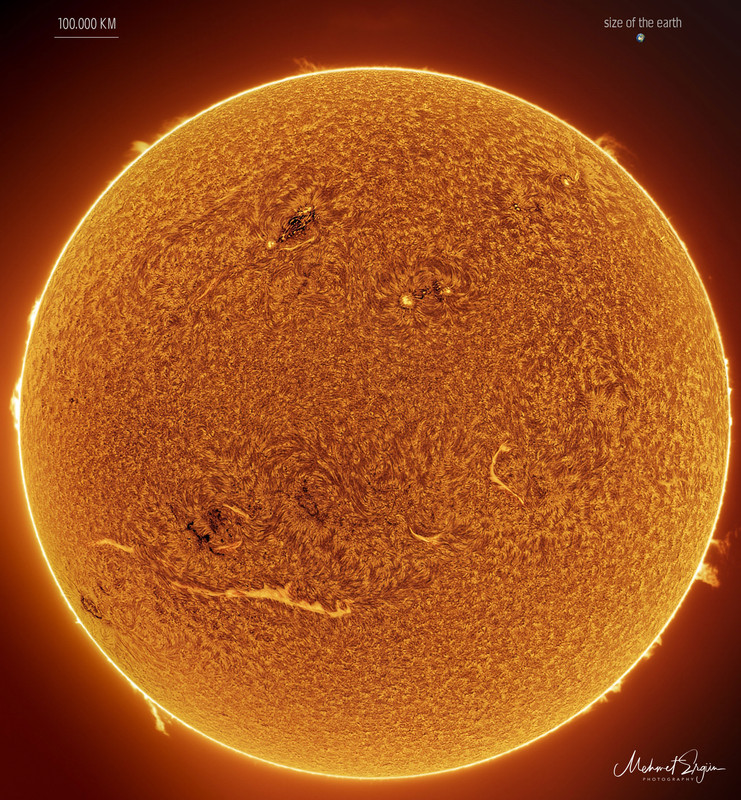
Planetary nebula Jones-Emberson 1 is the death shroud of a dying Sun-like star. It lies some 1,600 light-years from Earth toward the sharp-eyed constellation Lynx. About 4 light-years across, the expanding remnant of the dying star's atmosphere was shrugged off into interstellar space, as the star's central supply of hydrogen and then helium for fusion was finally depleted after billions of years. Visible near the center of the planetary nebula is what remains of the stellar core, a blue-hot white dwarf star. Also known as PK 164 +31.1, the nebula is faint and very difficult to glimpse at a telescope's eyepiece. But this deep broadband image combining 22 hours of exposure time does show it off in exceptional detail. Stars within our own Milky Way galaxy as well as background galaxies across the universe are scattered through the clear field of view. Ephemeral on the cosmic stage, Jones-Emberson 1 will fade away over the next few thousand years. Its hot, central white dwarf star will take billions of years to cool.
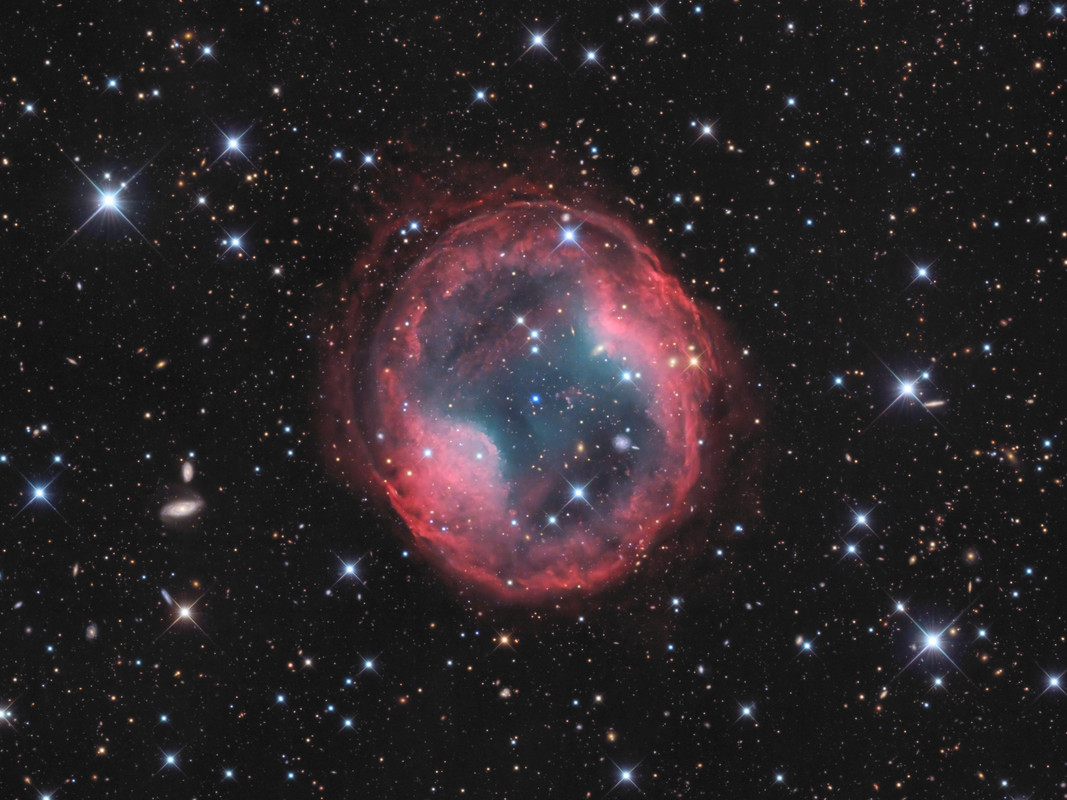

Imagine traveling to a star about 100 times as massive as our Sun, a million times more luminous, and with 30 times the surface temperature. Such stars exist, and some are known as Wolf Rayet (WR) stars, named after French astronomers Charles Wolf and Georges Rayet. The central star in this image is WR 40 which is located toward the constellation of Carina. Stars like WR 40 live fast and die young in comparison with the Sun. They quickly exhaust their core hydrogen supply, move on to fusing heavier core elements, and expand while ejecting their outer layers via high stellar winds. In this case, the central star WR 40 ejects the atmosphere at a speed of nearly 100 kilometers per second, and these outer layers have become the expanding oval-shaped nebula RCW 58.

Fading as it races across planet Earth's northern skies comet C/2022 E3 (ZTF) shares this telescopic frame with comet C/2022 U2 (ATLAS). Captured on the night of February 6 from a garden observatory in Germany's Bavarian Forest, the starry field of view toward the constellation Auriga spans about 2.5 degrees. Discovered by sky survey projects in 2022 (the Zwicky Transient Facility and the Asteroid Terrestrial-impact Last Alert System) these long-period comets are outbound, reaching perihelion just last month. The much fainter comet ATLAS made its closest approach to our fair planet on January 29 at a distance of about 4.6 light-minutes, compared to a mere 2.4 light-minutes for comet ZTF on February 2. This comet ATLAS lacks the well-developed tails of the formerly naked-eye comet ZTF. But both comets sport greenish tinted comas, emission from diatomic carbon molecules fluorescing in sunlight.

A mere 56 million light-years distant toward the southern constellation Fornax, NGC 1365 is an enormous barred spiral galaxy about 200,000 light-years in diameter. That's twice the size of our own barred spiral Milky Way. This sharp image from the James Webb Space Telescope's Mid-Infrared Instrument (MIRI) reveals stunning details of this magnificent spiral in infrared light. Webb's field of view stretches about 60,000 light-years across NGC 1365, exploring the galaxy's core and bright newborn star clusters. The intricate network of dusty filaments and bubbles is created by young stars along spiral arms winding from the galaxy's central bar. Astronomers suspect the gravity field of NGC 1365's bar plays a crucial role in the galaxy's evolution, funneling gas and dust into a star-forming maelstrom and ultimately feeding material into the active galaxy's central, supermassive black hole.

Is this really the famous Pleiades star cluster? Known for its iconic blue stars, the Pleiades is shown here in infrared light where the surrounding dust outshines the stars. Here three infrared colors have been mapped into visual colors (R=24, G=12, B=4.6 microns). The base images were taken by NASA's orbiting Wide Field Infrared Survey Explorer (WISE) spacecraft. Cataloged as M45 and nicknamed the Seven Sisters, the Pleiades star cluster is by chance situated in a passing dust cloud. The light and winds from the massive Pleiades stars preferentially repel smaller dust particles, causing the dust to become stratified into filaments, as seen. The featured image spans about 20 light years at the distance of the Pleiades, which lies about 450 light years distant toward the constellation of the Bull (Taurus).

Our Sun is becoming a busy place. Only two years ago, the Sun was emerging from a solar minimum so quiet that months would go by without even a single sunspot. In contrast, already this year and well ahead of schedule, our Sun is unusually active, already nearing solar activity levels seen a decade ago during the last solar maximum. Our increasingly active Sun was captured two weeks ago sporting numerous interesting features. The image was recorded in a single color of light called Hydrogen Alpha, color-inverted, and false colored. Spicules carpet much of the Sun's face. The brightening towards the Sun's edges is caused by increased absorption of relatively cool solar gas and called limb darkening. Just outside the Sun's disk, several scintillating prominences protrude, while prominences on the Sun's face are known as filaments and show as light streaks. Magnetically tangled active regions are both dark and light and contain cool sunspots. As our Sun's magnetic field winds toward solar maximum over the next few years, whether the Sun's high activity will continue to increase is unknown.

Planetary nebula Jones-Emberson 1 is the death shroud of a dying Sun-like star. It lies some 1,600 light-years from Earth toward the sharp-eyed constellation Lynx. About 4 light-years across, the expanding remnant of the dying star's atmosphere was shrugged off into interstellar space, as the star's central supply of hydrogen and then helium for fusion was finally depleted after billions of years. Visible near the center of the planetary nebula is what remains of the stellar core, a blue-hot white dwarf star. Also known as PK 164 +31.1, the nebula is faint and very difficult to glimpse at a telescope's eyepiece. But this deep broadband image combining 22 hours of exposure time does show it off in exceptional detail. Stars within our own Milky Way galaxy as well as background galaxies across the universe are scattered through the clear field of view. Ephemeral on the cosmic stage, Jones-Emberson 1 will fade away over the next few thousand years. Its hot, central white dwarf star will take billions of years to cool.

CrazyDiamond
HAL is a StarChild
Is star AE Aurigae on fire? No. Even though AE Aurigae is named the Flaming Star and the surrounding nebula IC 405 is named the Flaming Star Nebula, and even though the nebula appears to some like a swirling flame, there is no fire. Fire, typically defined as the rapid molecular acquisition of oxygen, happens only when sufficient oxygen is present and is not important in such high-energy, low-oxygen environments such as stars. The bright star AE Aurigae occurs near the center of the Flaming Star Nebula and is so hot it glows blue, emitting light so energetic it knocks electrons away from surrounding gas. When a proton recaptures an electron, light is emitted, as seen in the surrounding emission nebula. Captured here three weeks ago, the Flaming Star Nebula is visible near the composite image's center, between the red Tadpole Nebula on the left and blue-tailed Comet ZTF on the right. The Flaming Star Nebula lies about 1,500 light years distant, spans about 5 light years, and is visible with a small telescope toward the constellation of the Charioteer (Auriga).
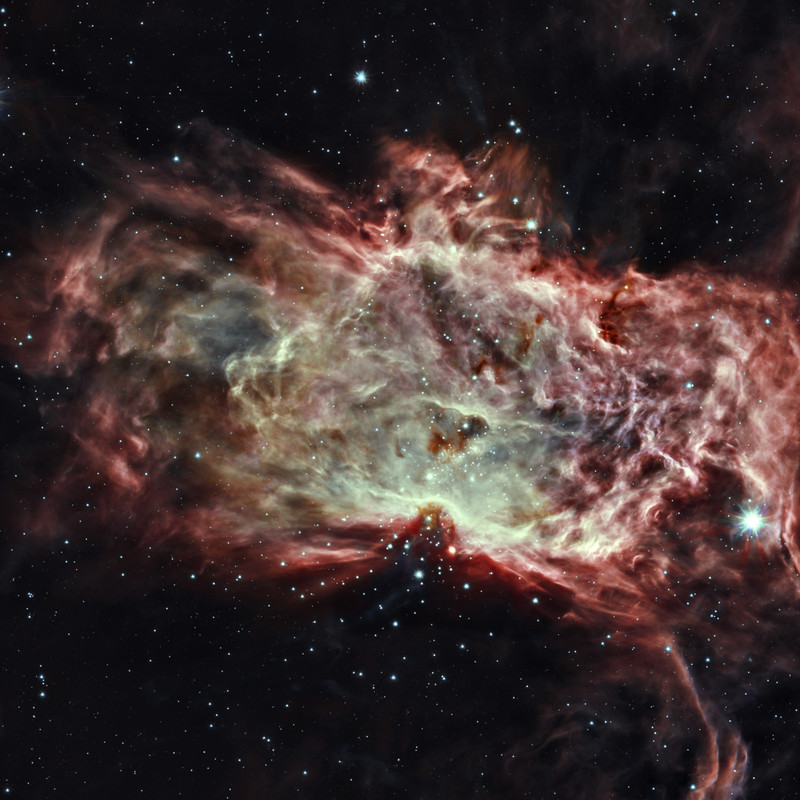
Few cosmic vistas excite the imagination like The Great Nebula in Orion. Visible as a faint celestial smudge to the naked-eye, the nearest large star-forming region sprawls across this sharp telescopic image, recorded on a cold January night in dark skies from West Virginia, planet Earth. Also known as M42, the Orion Nebula's glowing gas surrounds hot, young stars. About 40 light-years across, it lies at the edge of an immense interstellar molecular cloud only 1,500 light-years away within the same spiral arm of our Milky Way galaxy as the Sun. Along with dusty bluish reflection nebula NGC 1977 and friends near the top of the frame, the eye-catching nebulae represent only a small fraction of our galactic neighborhood's wealth of star-forming material. Within the well-studied stellar nursery, astronomers have also identified what appear to be numerous infant solar systems.
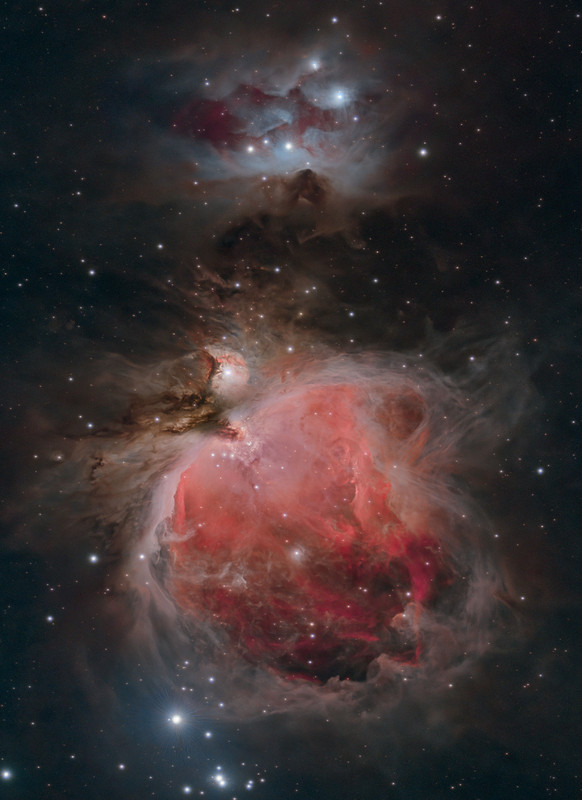
Stars are forming in the Soul of the Queen of Aethopia. More specifically, a large star forming region called the Soul Nebula can be found in the direction of the constellation Cassiopeia, whom Greek mythology credits as the vain wife of a King who long ago ruled lands surrounding the upper Nile river. Also known as Westerhout 5 (W5), the Soul Nebula houses several open clusters of stars, ridges and pillars darkened by cosmic dust, and huge evacuated bubbles formed by the winds of young massive stars. Located about 6,500 light years away, the Soul Nebula spans about 100 light years and is usually imaged next to its celestial neighbor the Heart Nebula (IC 1805). The featured image is a composite of exposures made in different colors: red as emitted by hydrogen gas, yellow as emitted by sulfur, and blue as emitted by oxygen.
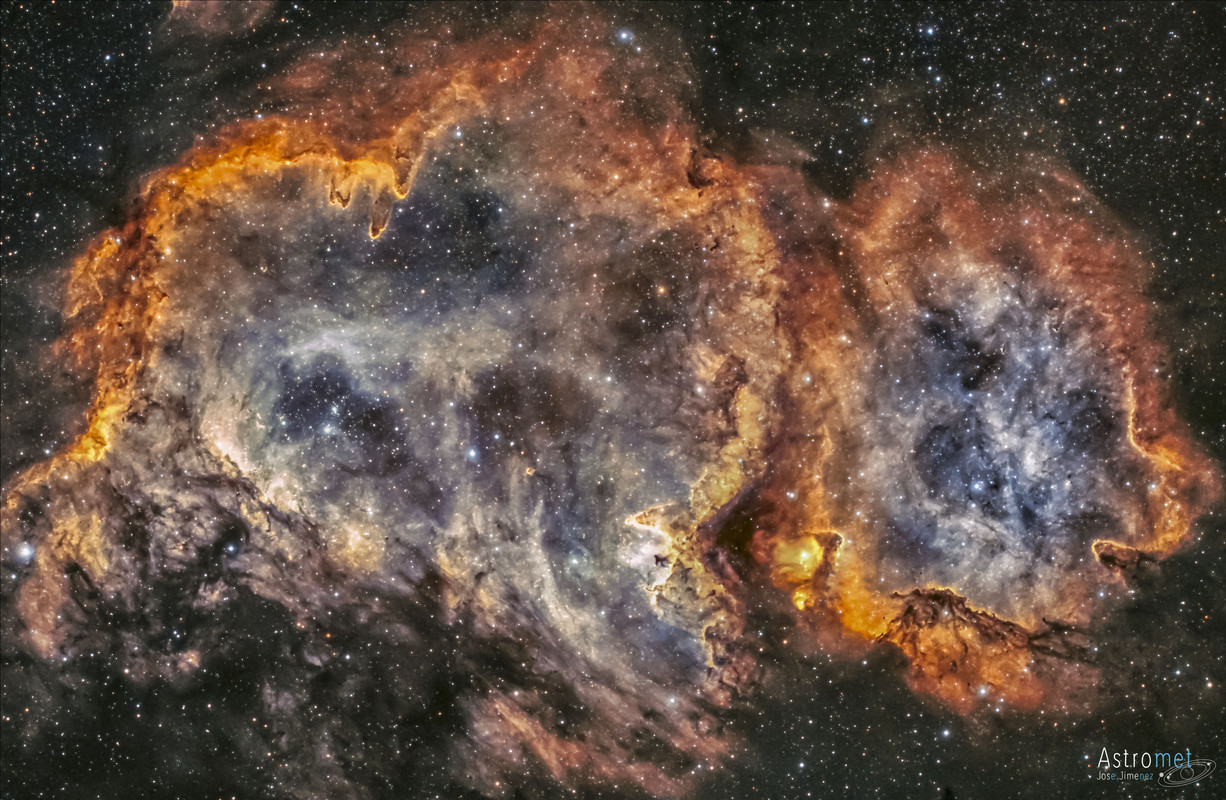
Globular star cluster Omega Centauri, also known as NGC 5139, is 15,000 light-years away. The cluster is packed with about 10 million stars much older than the Sun within a volume about 150 light-years in diameter. It's the largest and brightest of 200 or so known globular clusters that roam the halo of our Milky Way galaxy. Though most star clusters consist of stars with the same age and composition, the enigmatic Omega Cen exhibits the presence of different stellar populations with a spread of ages and chemical abundances. In fact, Omega Cen may be the remnant core of a small galaxy merging with the Milky Way. Omega Centauri's red giant stars (with a yellowish hue) are easy to pick out in this sharp, color telescopic view.
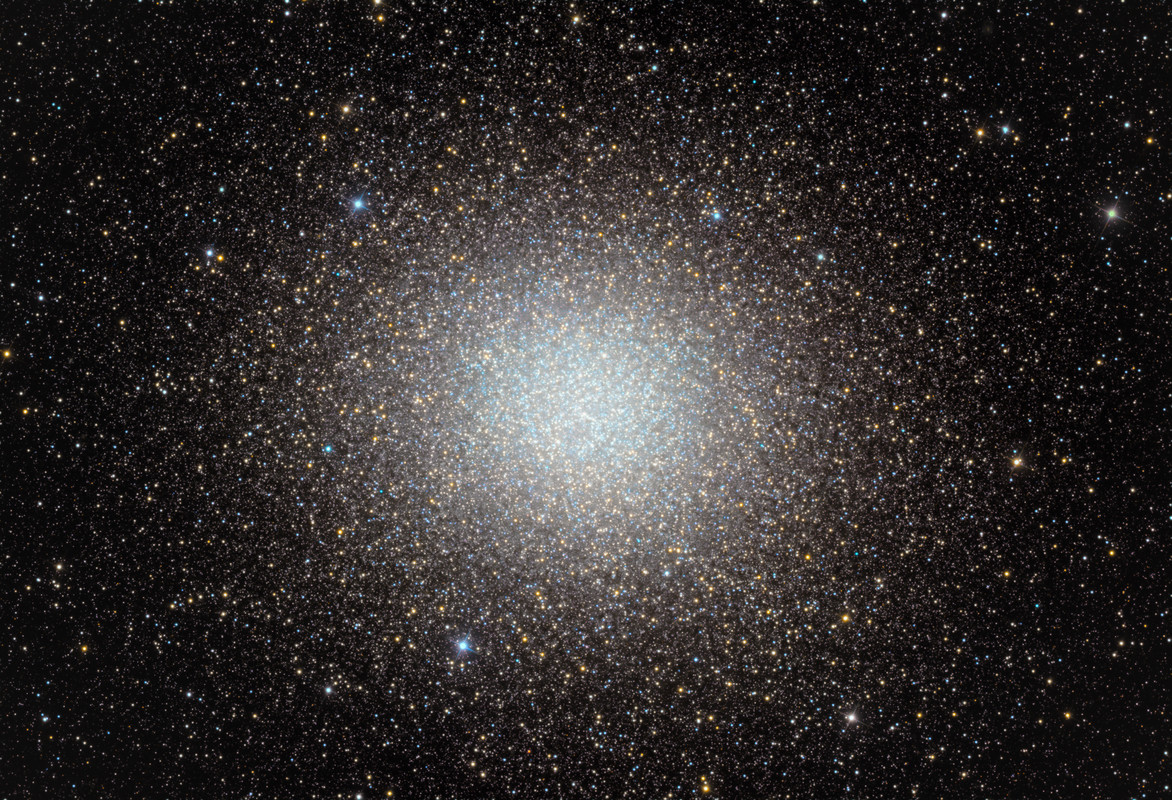
The luminous, hot star Wolf-Rayet 124 (WR 124) is prominent at the center of the James Webb Space Telescope’s composite image combining near-infrared and mid-infrared wavelengths of light. The star displays the characteristic diffraction spikes of Webb’s Near-Infrared Camera (NIRCam), caused by the physical structure of the telescope itself. NIRCam effectively balances the brightness of the star with the fainter gas and dust surrounding it, while Webb’s Mid-Infrared Instrument (MIRI) reveals the nebula’s structure.
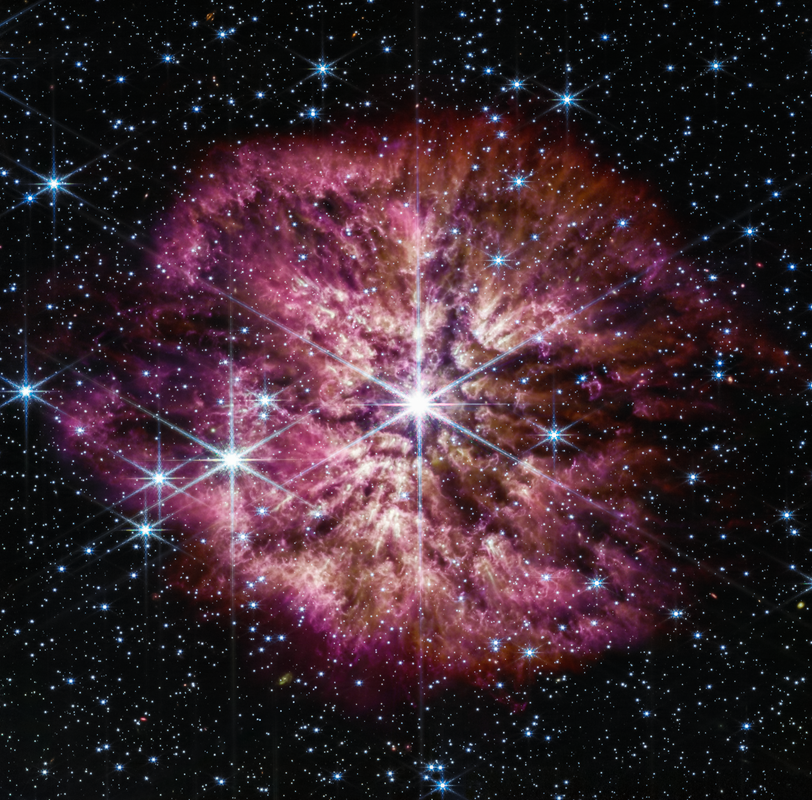
From JWST...Stars and galaxies, in shades of white and reddish orange, are scattered across a dark background. Larger stars resemble snowflakes due to their eight-pointed diffraction spike pattern. The galaxies come in an assortment of sizes and shapes: spirals, arcs, blobs and dots. In the upper right corner, there is a foreground galaxy cluster with a diffuse white glow. Behind the cluster are galaxies that have been magnified, distorted and multiplied due to the sheer mass and gravity of the cluster, an effect called gravitational lensing. One of these magnified galaxies is of note to astronomers. It appears three times in the upper right corner, and each of its appearances is highlighted with a small white box. This galaxy looks like a tiny orange spiral. In all three white boxes, there are other tiny orange or white light sources right next to it.

From JWST...Composite image of the Tarantula Nebula: Royal blue and purple gas clouds interact with red and orange gas clouds, as specks of light and large gleaming stars peek through. The blue and purple patches represent X-ray data from Chandra. The most striking blue cloud is shaped like an upward pointing triangle at the center. Wispy white clouds outline this blue triangle. Inside this frame is a gleaming star with six long, thin spikes. Beside it is a cluster of smaller bright blue specks showing young stars in the nebula. Darker X-ray clouds can be found near the right and left edges of the image. The red and orange gas clouds, which look like roiling fire, represent infrared data from Webb.
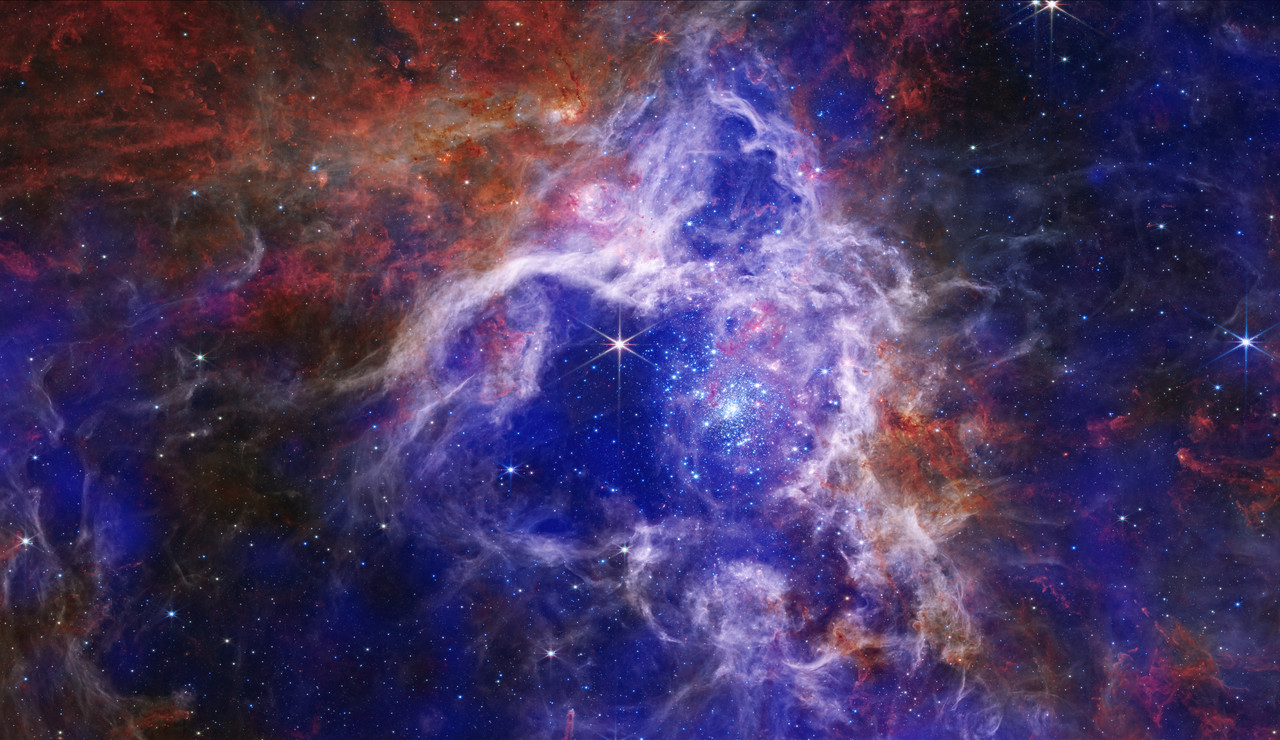
By combining images of the iconic Pillars of Creation from two cameras aboard NASA’s James Webb Space Telescope, the universe has been framed in its infrared glory. Webb’s near-infrared image was fused with its mid-infrared image, setting this star-forming region ablaze with new details.
Myriad stars are spread throughout the scene. The stars primarily show up in near-infrared light, marking a contribution of Webb’s Near-Infrared Camera (NIRCam). Near-infrared light also reveals thousands of newly formed stars – look for bright orange spheres that lie just outside the dusty pillars.
In mid-infrared light, the dust is on full display. The contributions from Webb’s Mid-Infrared Instrument (MIRI) are most apparent in the layers of diffuse, orange dust that drape the top of the image, relaxing into a V. The densest regions of dust are cast in deep indigo hues, obscuring our view of the activities inside the dense pillars.
Dust also makes up the spire-like pillars that extend from the bottom left to the top right. This is one of the reasons why the region is overflowing with stars – dust is a major ingredient of star formation. When knots of gas and dust with sufficient mass form in the pillars, they begin to collapse under their own gravitational attraction, slowly heat up, and eventually form new stars. Newly formed stars are especially apparent at the edges of the top two pillars – they are practically bursting onto the scene.
At the top edge of the second pillar, undulating detail in red hints at even more embedded stars. These are even younger, and are quite active as they form. The lava-like regions capture their periodic ejections. As stars form, they periodically send out supersonic jets that can interact within clouds of material, like these thick pillars of gas and dust. These young stars are estimated to be only a few hundred thousand years old, and will continue to form for millions of years.
Almost everything you see in this scene is local. The distant universe is largely blocked from our view both by the interstellar medium, which is made up of sparse gas and dust located between the stars, and a thick dust lane in our Milky Way galaxy. As a result, the stars take center stage in Webb’s view of the Pillars of Creation.
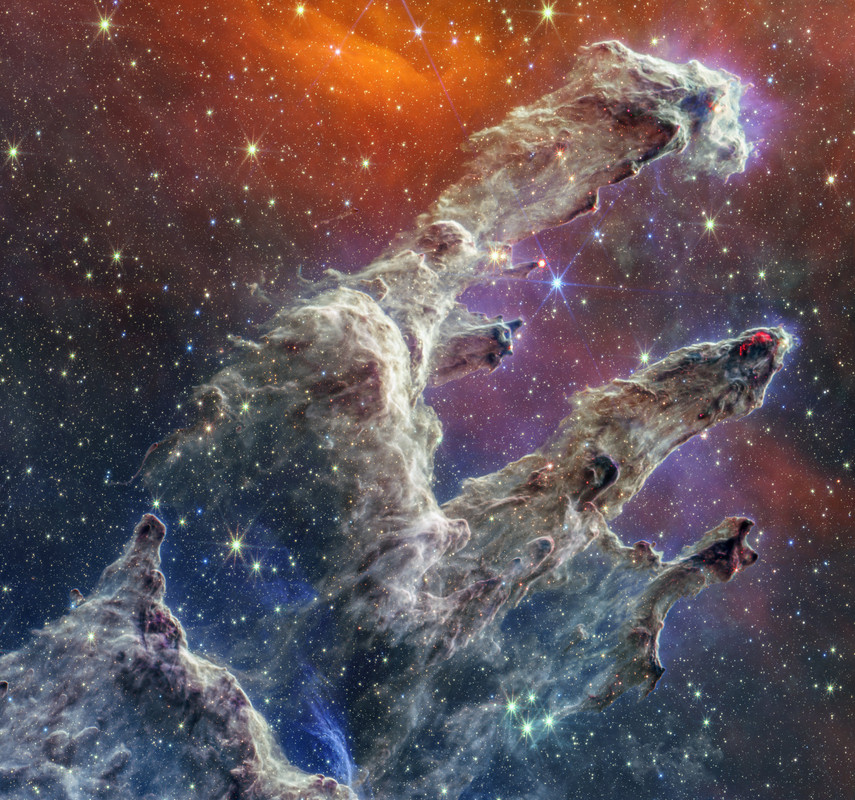

Few cosmic vistas excite the imagination like The Great Nebula in Orion. Visible as a faint celestial smudge to the naked-eye, the nearest large star-forming region sprawls across this sharp telescopic image, recorded on a cold January night in dark skies from West Virginia, planet Earth. Also known as M42, the Orion Nebula's glowing gas surrounds hot, young stars. About 40 light-years across, it lies at the edge of an immense interstellar molecular cloud only 1,500 light-years away within the same spiral arm of our Milky Way galaxy as the Sun. Along with dusty bluish reflection nebula NGC 1977 and friends near the top of the frame, the eye-catching nebulae represent only a small fraction of our galactic neighborhood's wealth of star-forming material. Within the well-studied stellar nursery, astronomers have also identified what appear to be numerous infant solar systems.

Stars are forming in the Soul of the Queen of Aethopia. More specifically, a large star forming region called the Soul Nebula can be found in the direction of the constellation Cassiopeia, whom Greek mythology credits as the vain wife of a King who long ago ruled lands surrounding the upper Nile river. Also known as Westerhout 5 (W5), the Soul Nebula houses several open clusters of stars, ridges and pillars darkened by cosmic dust, and huge evacuated bubbles formed by the winds of young massive stars. Located about 6,500 light years away, the Soul Nebula spans about 100 light years and is usually imaged next to its celestial neighbor the Heart Nebula (IC 1805). The featured image is a composite of exposures made in different colors: red as emitted by hydrogen gas, yellow as emitted by sulfur, and blue as emitted by oxygen.

Globular star cluster Omega Centauri, also known as NGC 5139, is 15,000 light-years away. The cluster is packed with about 10 million stars much older than the Sun within a volume about 150 light-years in diameter. It's the largest and brightest of 200 or so known globular clusters that roam the halo of our Milky Way galaxy. Though most star clusters consist of stars with the same age and composition, the enigmatic Omega Cen exhibits the presence of different stellar populations with a spread of ages and chemical abundances. In fact, Omega Cen may be the remnant core of a small galaxy merging with the Milky Way. Omega Centauri's red giant stars (with a yellowish hue) are easy to pick out in this sharp, color telescopic view.

The luminous, hot star Wolf-Rayet 124 (WR 124) is prominent at the center of the James Webb Space Telescope’s composite image combining near-infrared and mid-infrared wavelengths of light. The star displays the characteristic diffraction spikes of Webb’s Near-Infrared Camera (NIRCam), caused by the physical structure of the telescope itself. NIRCam effectively balances the brightness of the star with the fainter gas and dust surrounding it, while Webb’s Mid-Infrared Instrument (MIRI) reveals the nebula’s structure.

From JWST...Stars and galaxies, in shades of white and reddish orange, are scattered across a dark background. Larger stars resemble snowflakes due to their eight-pointed diffraction spike pattern. The galaxies come in an assortment of sizes and shapes: spirals, arcs, blobs and dots. In the upper right corner, there is a foreground galaxy cluster with a diffuse white glow. Behind the cluster are galaxies that have been magnified, distorted and multiplied due to the sheer mass and gravity of the cluster, an effect called gravitational lensing. One of these magnified galaxies is of note to astronomers. It appears three times in the upper right corner, and each of its appearances is highlighted with a small white box. This galaxy looks like a tiny orange spiral. In all three white boxes, there are other tiny orange or white light sources right next to it.

From JWST...Composite image of the Tarantula Nebula: Royal blue and purple gas clouds interact with red and orange gas clouds, as specks of light and large gleaming stars peek through. The blue and purple patches represent X-ray data from Chandra. The most striking blue cloud is shaped like an upward pointing triangle at the center. Wispy white clouds outline this blue triangle. Inside this frame is a gleaming star with six long, thin spikes. Beside it is a cluster of smaller bright blue specks showing young stars in the nebula. Darker X-ray clouds can be found near the right and left edges of the image. The red and orange gas clouds, which look like roiling fire, represent infrared data from Webb.

By combining images of the iconic Pillars of Creation from two cameras aboard NASA’s James Webb Space Telescope, the universe has been framed in its infrared glory. Webb’s near-infrared image was fused with its mid-infrared image, setting this star-forming region ablaze with new details.
Myriad stars are spread throughout the scene. The stars primarily show up in near-infrared light, marking a contribution of Webb’s Near-Infrared Camera (NIRCam). Near-infrared light also reveals thousands of newly formed stars – look for bright orange spheres that lie just outside the dusty pillars.
In mid-infrared light, the dust is on full display. The contributions from Webb’s Mid-Infrared Instrument (MIRI) are most apparent in the layers of diffuse, orange dust that drape the top of the image, relaxing into a V. The densest regions of dust are cast in deep indigo hues, obscuring our view of the activities inside the dense pillars.
Dust also makes up the spire-like pillars that extend from the bottom left to the top right. This is one of the reasons why the region is overflowing with stars – dust is a major ingredient of star formation. When knots of gas and dust with sufficient mass form in the pillars, they begin to collapse under their own gravitational attraction, slowly heat up, and eventually form new stars. Newly formed stars are especially apparent at the edges of the top two pillars – they are practically bursting onto the scene.
At the top edge of the second pillar, undulating detail in red hints at even more embedded stars. These are even younger, and are quite active as they form. The lava-like regions capture their periodic ejections. As stars form, they periodically send out supersonic jets that can interact within clouds of material, like these thick pillars of gas and dust. These young stars are estimated to be only a few hundred thousand years old, and will continue to form for millions of years.
Almost everything you see in this scene is local. The distant universe is largely blocked from our view both by the interstellar medium, which is made up of sparse gas and dust located between the stars, and a thick dust lane in our Milky Way galaxy. As a result, the stars take center stage in Webb’s view of the Pillars of Creation.

CANtalk
Well-Known Member
CANtalk
Well-Known Member
https://www.reddit.com/r/space/comments/122oibd
Still not unfurling, so here's the picture

They will be colliding in ~4.5 billion years



They will be colliding in ~4.5 billion years


Last edited:
florduh
Well-Known Member
How the night's sky will evolve as Andromeda grows closer

This series of photo illustrations shows the predicted merger between our Milky Way galaxy and the neighboring Andromeda galaxy.
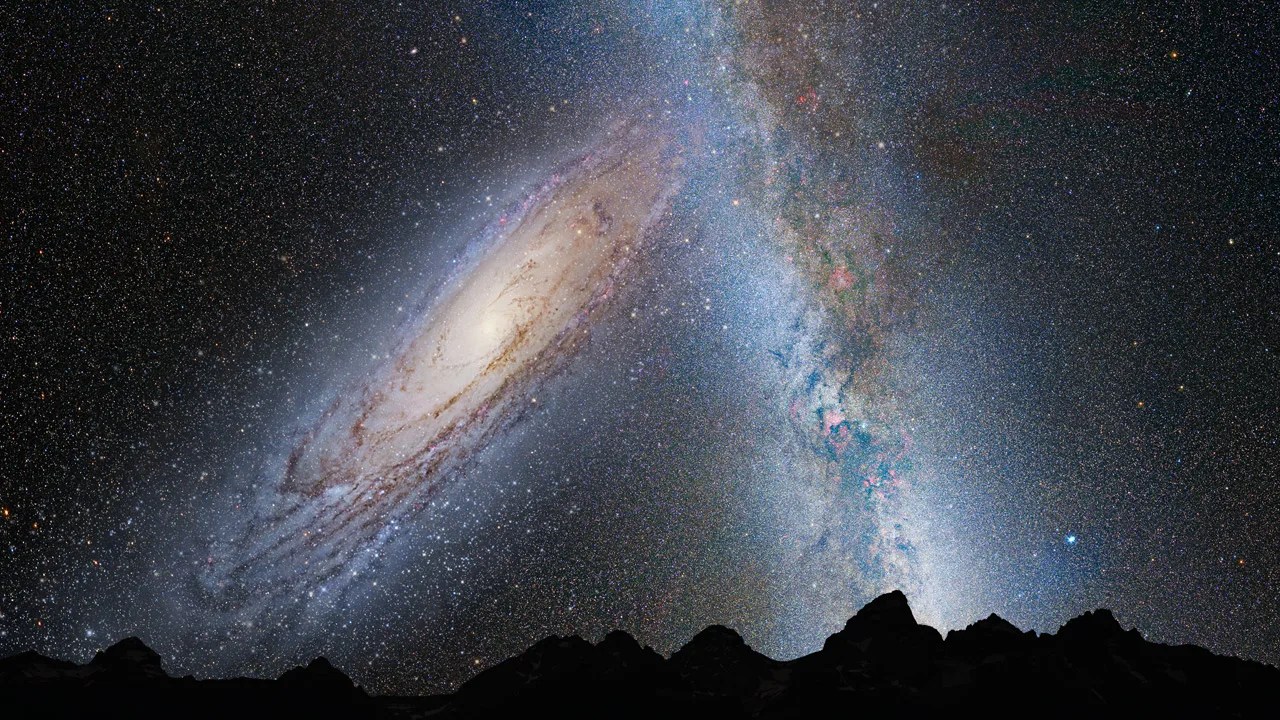
 www.nasa.gov
www.nasa.gov

This series of photo illustrations shows the predicted merger between our Milky Way galaxy and the neighboring Andromeda galaxy.
- First Row, Left: Present day.
- First Row, Right: In 2 billion years the disk of the approaching Andromeda galaxy is noticeably larger.
- Second Row, Left: In 3.75 billion years Andromeda fills the field of view.
- Second Row, Right: In 3.85 billion years the sky is ablaze with new star formation.
- Third Row, Left: In 3.9 billion years, star formation continues.
- Third Row, Right: In 4 billion years Andromeda is tidally stretched and the Milky Way becomes warped.
- Fourth Row, Left: In 5.1 billion years the cores of the Milky Way and Andromeda appear as a pair of bright lobes.
- Fourth Row, Right: In 7 billion years the merged galaxies form a huge elliptical galaxy, its bright core dominating the nighttime sky.

NASA's Hubble Shows Milky Way is Destined for Head-On Collision - NASA Science
The Milky Way is destined to get a major makeover during an encounter with the Andromeda galaxy, predicted to happen 4 billion years from now.

Astronomers discover one of biggest black holes ever recorded
One of the largest black holes ever recorded has been discovered using a new technique that could spot thousands more of the insatiable celestial monsters in the coming years, according to astronomers.The ultramassive black hole, one of just four ever observed, is more than 30 billion times the...
 www.rawstory.com
www.rawstory.com
/cloudfront-us-east-2.images.arcpublishing.com/reuters/XZBB6KELJBNPPC3XERH5C2UV2E.jpg)
NASA names woman, Black astronauts to Artemis II crew in lunar first
NASA on Monday named the first woman and the first African American ever assigned as astronauts to a lunar mission, introducing them as part of the four-member team chosen to fly on what would be the first crewed voyage around the moon in more than 50 years.
olysh pops
Well-Known Member
Hi,
Is that Jupiter and its satellites in the background of the moon?
Thanks for the picture.
olysh pops
Well-Known Member
Reading a bit of the wikipedia page dedicated to the Galilean satellites, I read that Io, the most important satellite is essentially composed of silicate. Silicate ! It is the insulator used in the Vapman, what a small world ! 

coolbreeze
Well-Known Member
Reading a bit of the wikipedia page dedicated to the Galilean satellites, I read that Io, the most important satellite is essentially composed of silicate. Silicate ! It is the insulator used in the Vapman, what a small world !
CrazyDiamond
HAL is a StarChild
The Horta silicon based life form
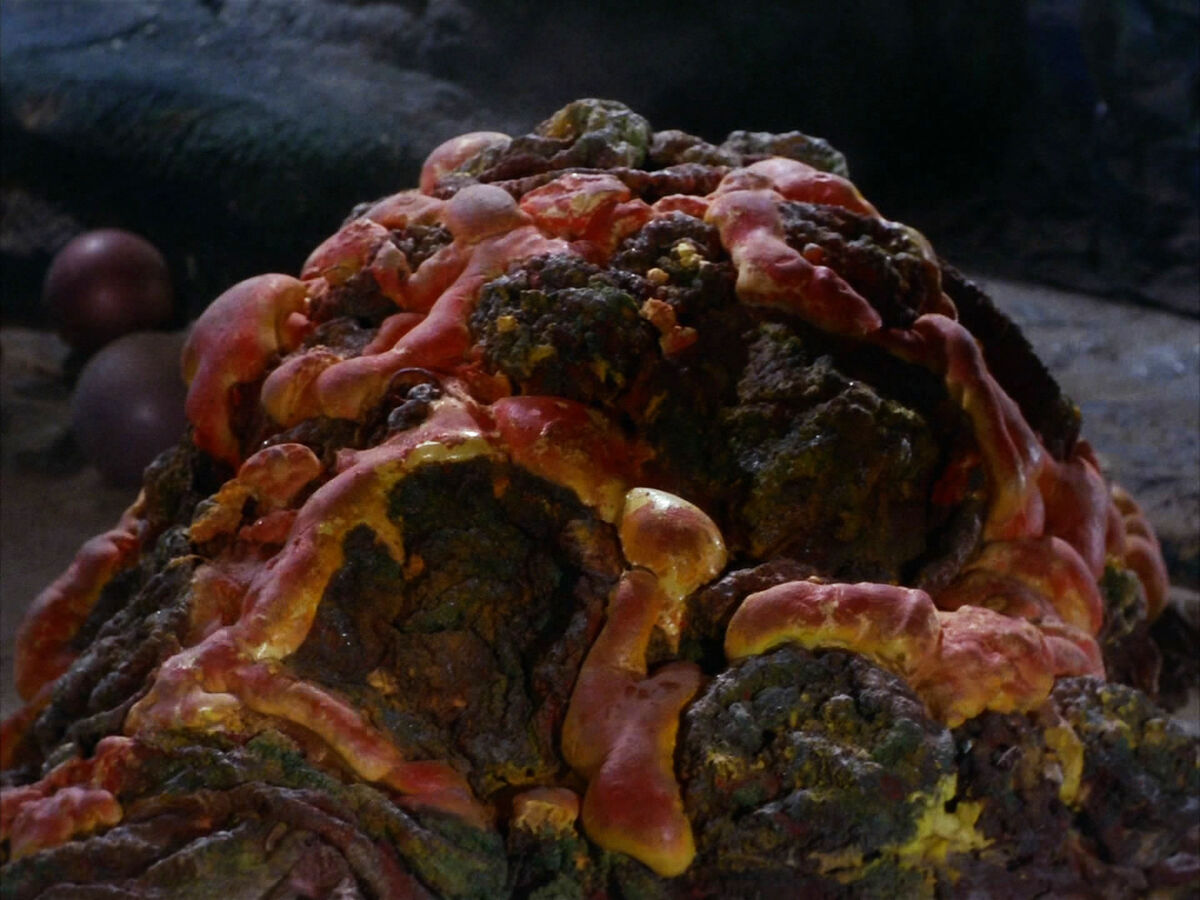
 memory-alpha.fandom.com
memory-alpha.fandom.com

Horta
The Horta were a sentient non-humanoid silicon cycle life form native to the planet Janus VI. Horta anatomy was composed of a material similar to fibrous asbestos. Horta physiology was very different from the carbon-based lifeforms more commonly found in the galaxy. Horta were difficult to...
CrazyDiamond
HAL is a StarChild
Love me anything Trek, lol...
Distorted galaxy NGC 2442 can be found in the southern constellation of the flying fish, (Piscis) Volans. Located about 50 million light-years away, the galaxy's two spiral arms extending from a pronounced central bar give it a hook-shaped appearance in this deep colorful image, with spiky foreground stars scattered across the telescopic field of view. The image also reveals the distant galaxy's obscuring dust lanes, young blue star clusters and reddish star forming regions surrounding a core of yellowish light from an older population of stars. But the star forming regions seem more concentrated along the drawn-out (upper right) spiral arm. The distorted structure is likely the result of an ancient close encounter with the smaller galaxy seen near the top left of the frame. The two interacting galaxies are separated by about 150,000 light-years at the estimated distance of NGC 2442.
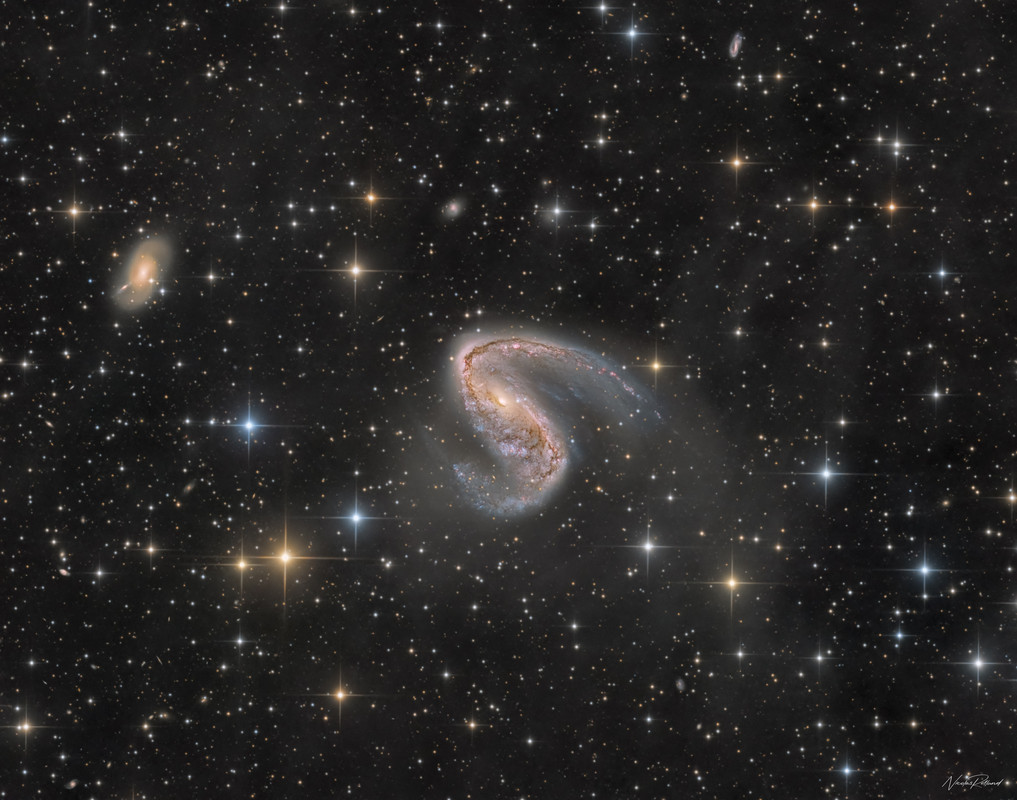
Can dust be beautiful? Yes, and it can also be useful. The Taurus molecular cloud has several bright stars, but it is the dark dust that really draws attention. The pervasive dust has waves and ripples and makes picturesque dust bunnies, but perhaps more importantly, it marks regions where interstellar gas is dense enough to gravitationally contract to form stars. In the image center is a light cloud lit by neighboring stars that is home not only to a famous nebula, but to a very young and massive famous star. Both the star, T Tauri, and the nebula, Hind's Variable Nebula, are seen to vary dramatically in brightness -- but not necessarily at the same time, adding to the mystery of this intriguing region. T Tauri and similar stars are now generally recognized to be Sun-like stars that are less than a few million years old and so still in the early stages of formation. The featured image spans about four degrees not far from the Pleiades star cluster, while the featured dust field lies about 400 light-years away.
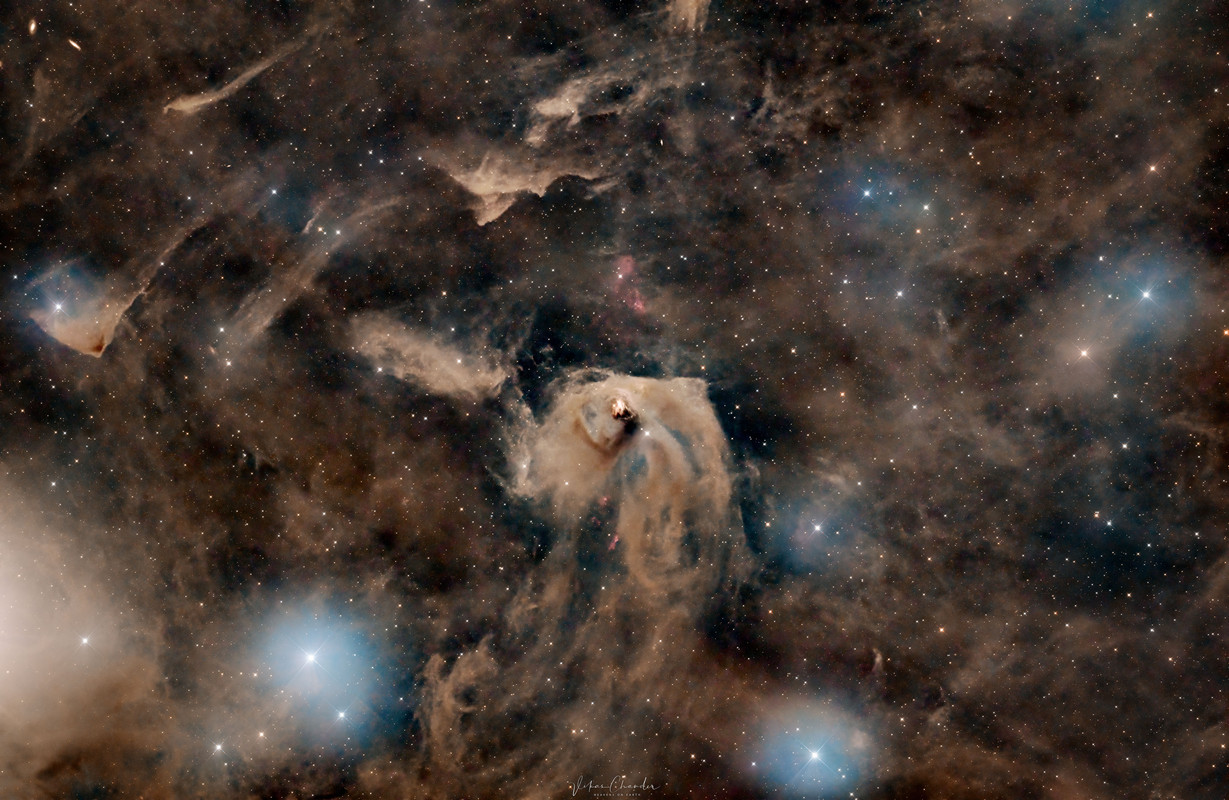
How far can you see? The most distant object easily visible to the unaided eye is M31, the great Andromeda Galaxy, over two million light-years away. Without a telescope, even this immense spiral galaxy appears as an unremarkable, faint, nebulous cloud in the constellation Andromeda. But a bright white nucleus, dark winding dust lanes, luminous blue spiral arms, and bright red emission nebulas are recorded in this stunning fifteen-hour telescopic digital mosaic of our closest major galactic neighbor. But how do we know this spiral nebula is really so far away? This question was central to the famous Shapley-Curtis debate of 1920. M31's great distance was determined in the 1920s by observations that resolved individual stars that changed their brightness in a way that gave up their true distance. The result proved that Andromeda is just like our Milky Way Galaxy -- a conclusion making the rest of the universe much more vast than had ever been previously imagined.
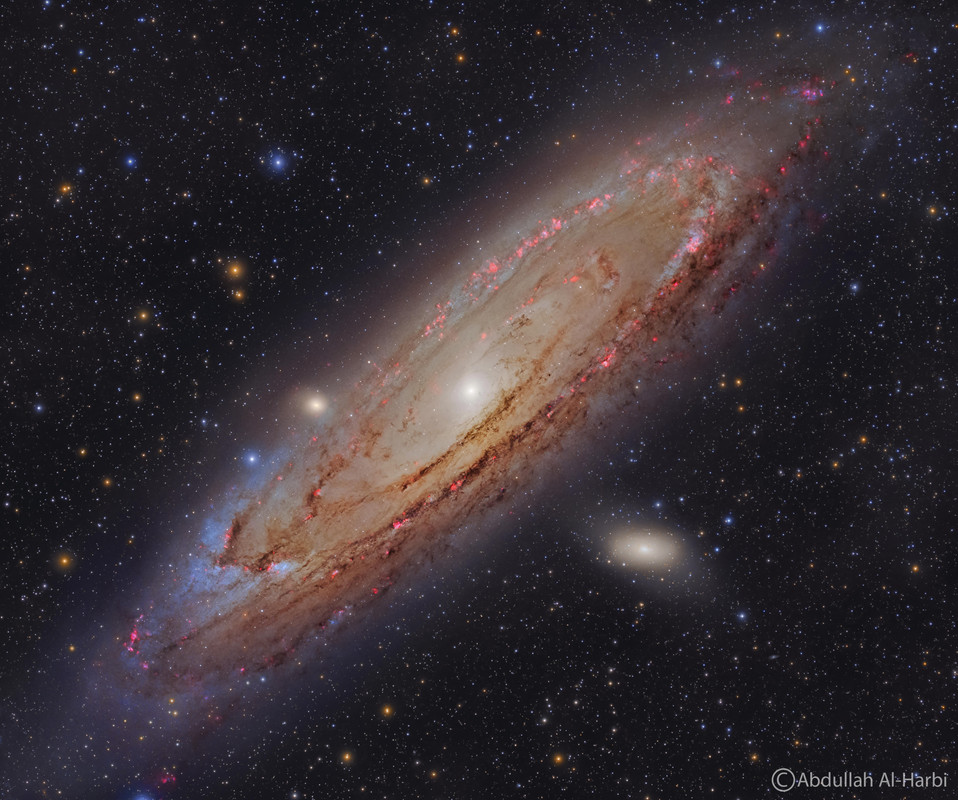
Which star created this bubble? It wasn't the bright star on the bubble's right. And it also wasn't a giant space dolphin. It was the star in the blue nebula's center, a famously energetic Wolf-Rayet star. Wolf-Rayet stars in general have over 20 times the mass of our Sun and expel fast particle winds that can create iconic looking nebulas. In this case, the resulting star bubble spans over 60 light years, is about 70,000 years old, and happens to look like the head of a dolphin. Named Sh2-308 and dubbed the Dolphin-Head Nebula, the gas ball lies about 5,000 light years away and covers as much sky as the full moon -- although it is much dimmer. The nearby red-tinged clouds on the left of the featured image may owe their glow and shape to energetic light emitted from the same Wolf-Rayet star.
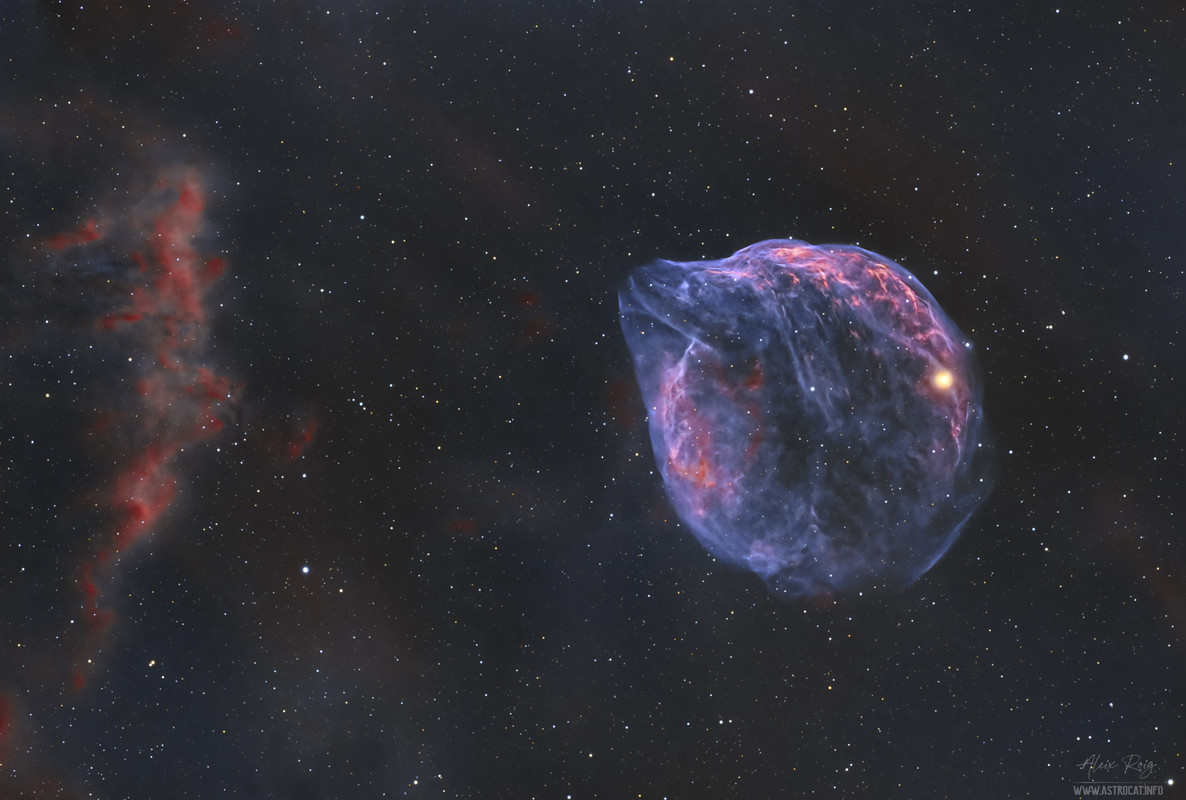
A visible-light image of the Sh2-54 nebula, captured by the VLT Survey Telescope at ESO’s Paranal Observatory in Chile. At these wavelengths the structure of the nebula is clear and the clouds of dust and gas block the light of stars within and behind it.
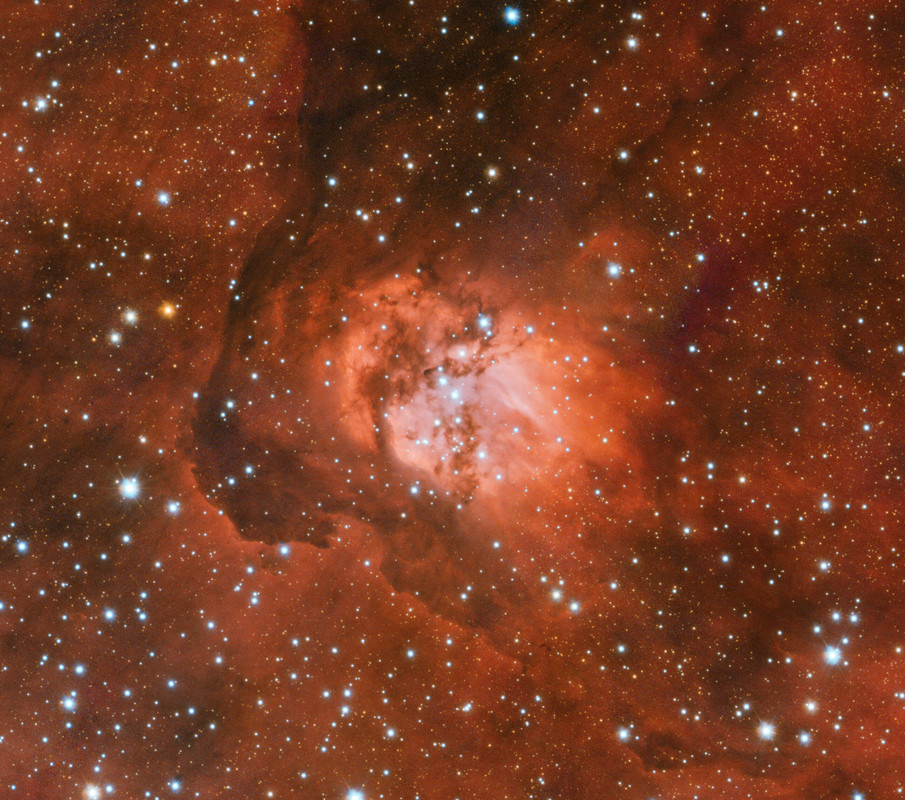
This image of the spectacular Sh2-54 nebula was taken in infrared light using ESO’s VISTA telescope at Paranal Observatory in Chile. The clouds of dust and gas that are normally obvious in visible light are less evident here, and in this light we can see the light of the stars behind the nebulae now piercing through.
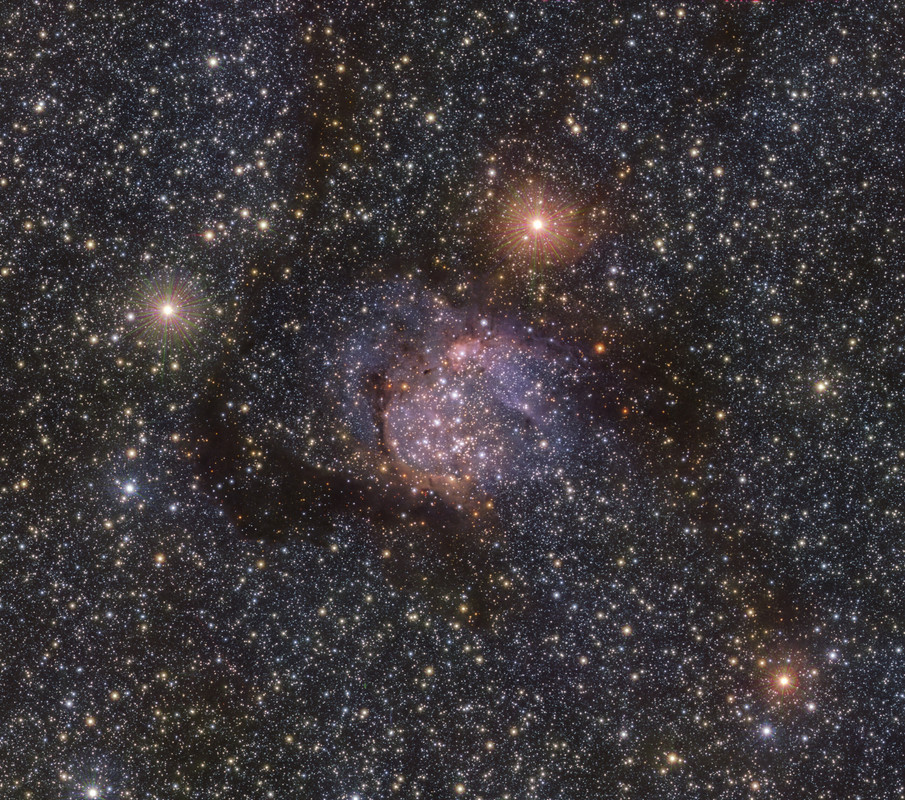
An ocean of stars is an apt description for IC4701 nebula. This nebula is located in the Sagittarius constellation, and it is twice as wide as the full Moon in the sky. The energetic light from newly-born stars ionizes the hydrogen gas in the nebula, causing it to emit the intense reddish hue seen in this picture. The dark clouds in this image contain large amounts of interstellar dust, too dense for the light of the background stars to pierce through it.
The IC4701 nebula is part of a rich and vast complex of dust and gas within which new stars spring to life. When stars are born, most of them are cooler, redder, and less massive than our own Sun. Hotter, more massive stars are much rarer, and they quickly burn through all their fuel and die. This makes these brilliant blue and massive stars, and their surrounding glowing gas, beacons of recent star formation.

This image from the Digitized Sky Survey (DSS) shows the region of the sky around the Cone Nebula. The nebulous area at the center of the image is NGC 2264, an area of the sky that includes the Christmas Tree star cluster and the Cone Nebula below it (at the very center of the frame).

Distorted galaxy NGC 2442 can be found in the southern constellation of the flying fish, (Piscis) Volans. Located about 50 million light-years away, the galaxy's two spiral arms extending from a pronounced central bar give it a hook-shaped appearance in this deep colorful image, with spiky foreground stars scattered across the telescopic field of view. The image also reveals the distant galaxy's obscuring dust lanes, young blue star clusters and reddish star forming regions surrounding a core of yellowish light from an older population of stars. But the star forming regions seem more concentrated along the drawn-out (upper right) spiral arm. The distorted structure is likely the result of an ancient close encounter with the smaller galaxy seen near the top left of the frame. The two interacting galaxies are separated by about 150,000 light-years at the estimated distance of NGC 2442.

Can dust be beautiful? Yes, and it can also be useful. The Taurus molecular cloud has several bright stars, but it is the dark dust that really draws attention. The pervasive dust has waves and ripples and makes picturesque dust bunnies, but perhaps more importantly, it marks regions where interstellar gas is dense enough to gravitationally contract to form stars. In the image center is a light cloud lit by neighboring stars that is home not only to a famous nebula, but to a very young and massive famous star. Both the star, T Tauri, and the nebula, Hind's Variable Nebula, are seen to vary dramatically in brightness -- but not necessarily at the same time, adding to the mystery of this intriguing region. T Tauri and similar stars are now generally recognized to be Sun-like stars that are less than a few million years old and so still in the early stages of formation. The featured image spans about four degrees not far from the Pleiades star cluster, while the featured dust field lies about 400 light-years away.

How far can you see? The most distant object easily visible to the unaided eye is M31, the great Andromeda Galaxy, over two million light-years away. Without a telescope, even this immense spiral galaxy appears as an unremarkable, faint, nebulous cloud in the constellation Andromeda. But a bright white nucleus, dark winding dust lanes, luminous blue spiral arms, and bright red emission nebulas are recorded in this stunning fifteen-hour telescopic digital mosaic of our closest major galactic neighbor. But how do we know this spiral nebula is really so far away? This question was central to the famous Shapley-Curtis debate of 1920. M31's great distance was determined in the 1920s by observations that resolved individual stars that changed their brightness in a way that gave up their true distance. The result proved that Andromeda is just like our Milky Way Galaxy -- a conclusion making the rest of the universe much more vast than had ever been previously imagined.

Which star created this bubble? It wasn't the bright star on the bubble's right. And it also wasn't a giant space dolphin. It was the star in the blue nebula's center, a famously energetic Wolf-Rayet star. Wolf-Rayet stars in general have over 20 times the mass of our Sun and expel fast particle winds that can create iconic looking nebulas. In this case, the resulting star bubble spans over 60 light years, is about 70,000 years old, and happens to look like the head of a dolphin. Named Sh2-308 and dubbed the Dolphin-Head Nebula, the gas ball lies about 5,000 light years away and covers as much sky as the full moon -- although it is much dimmer. The nearby red-tinged clouds on the left of the featured image may owe their glow and shape to energetic light emitted from the same Wolf-Rayet star.

A visible-light image of the Sh2-54 nebula, captured by the VLT Survey Telescope at ESO’s Paranal Observatory in Chile. At these wavelengths the structure of the nebula is clear and the clouds of dust and gas block the light of stars within and behind it.

This image of the spectacular Sh2-54 nebula was taken in infrared light using ESO’s VISTA telescope at Paranal Observatory in Chile. The clouds of dust and gas that are normally obvious in visible light are less evident here, and in this light we can see the light of the stars behind the nebulae now piercing through.

An ocean of stars is an apt description for IC4701 nebula. This nebula is located in the Sagittarius constellation, and it is twice as wide as the full Moon in the sky. The energetic light from newly-born stars ionizes the hydrogen gas in the nebula, causing it to emit the intense reddish hue seen in this picture. The dark clouds in this image contain large amounts of interstellar dust, too dense for the light of the background stars to pierce through it.
The IC4701 nebula is part of a rich and vast complex of dust and gas within which new stars spring to life. When stars are born, most of them are cooler, redder, and less massive than our own Sun. Hotter, more massive stars are much rarer, and they quickly burn through all their fuel and die. This makes these brilliant blue and massive stars, and their surrounding glowing gas, beacons of recent star formation.

This image from the Digitized Sky Survey (DSS) shows the region of the sky around the Cone Nebula. The nebulous area at the center of the image is NGC 2264, an area of the sky that includes the Christmas Tree star cluster and the Cone Nebula below it (at the very center of the frame).

CANtalk
Well-Known Member
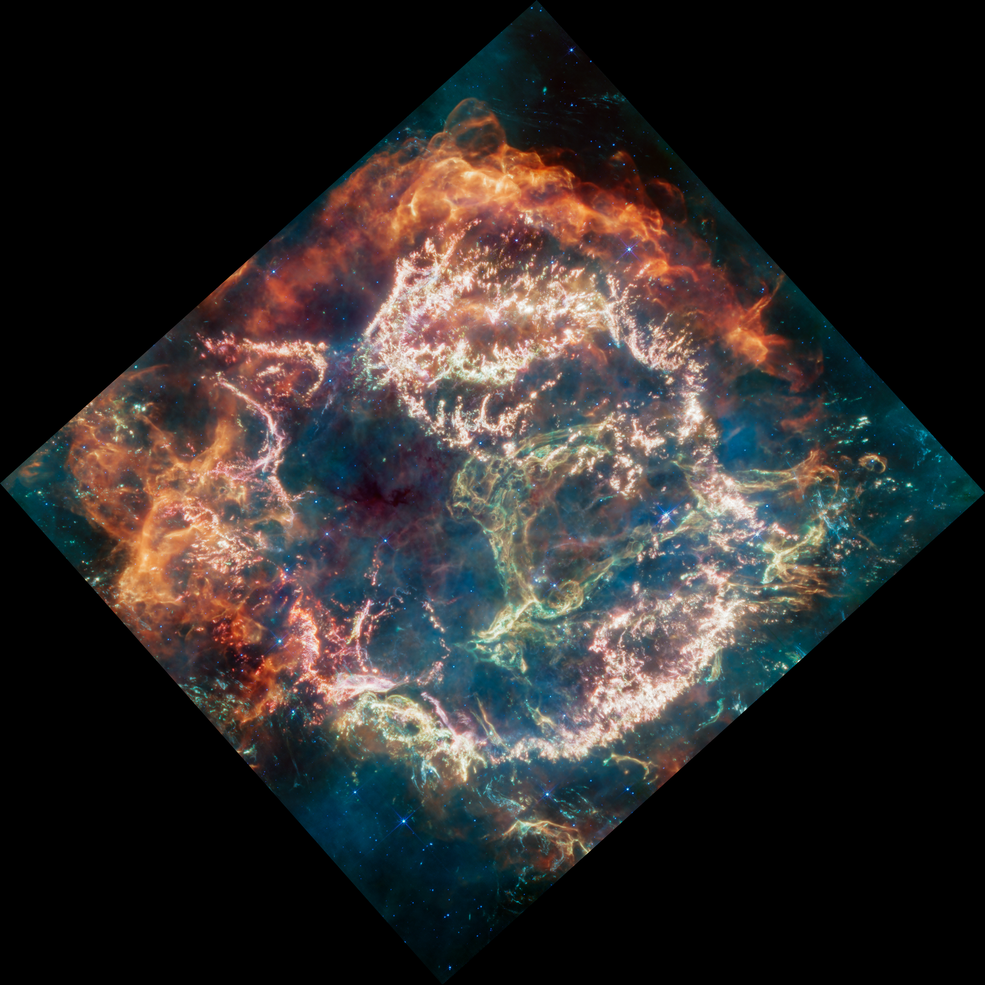
Webb Reveals Never-Before-Seen Details in Cassiopeia A - NASA
A new mid-infrared image from NASA’s James Webb Space Telescope shows the supernova remnant Cassiopeia A (Cas A), created by a stellar explosion seen from Earth 340 years ago. Cas A is the youngest known remnant from an exploding, massive star in our galaxy.
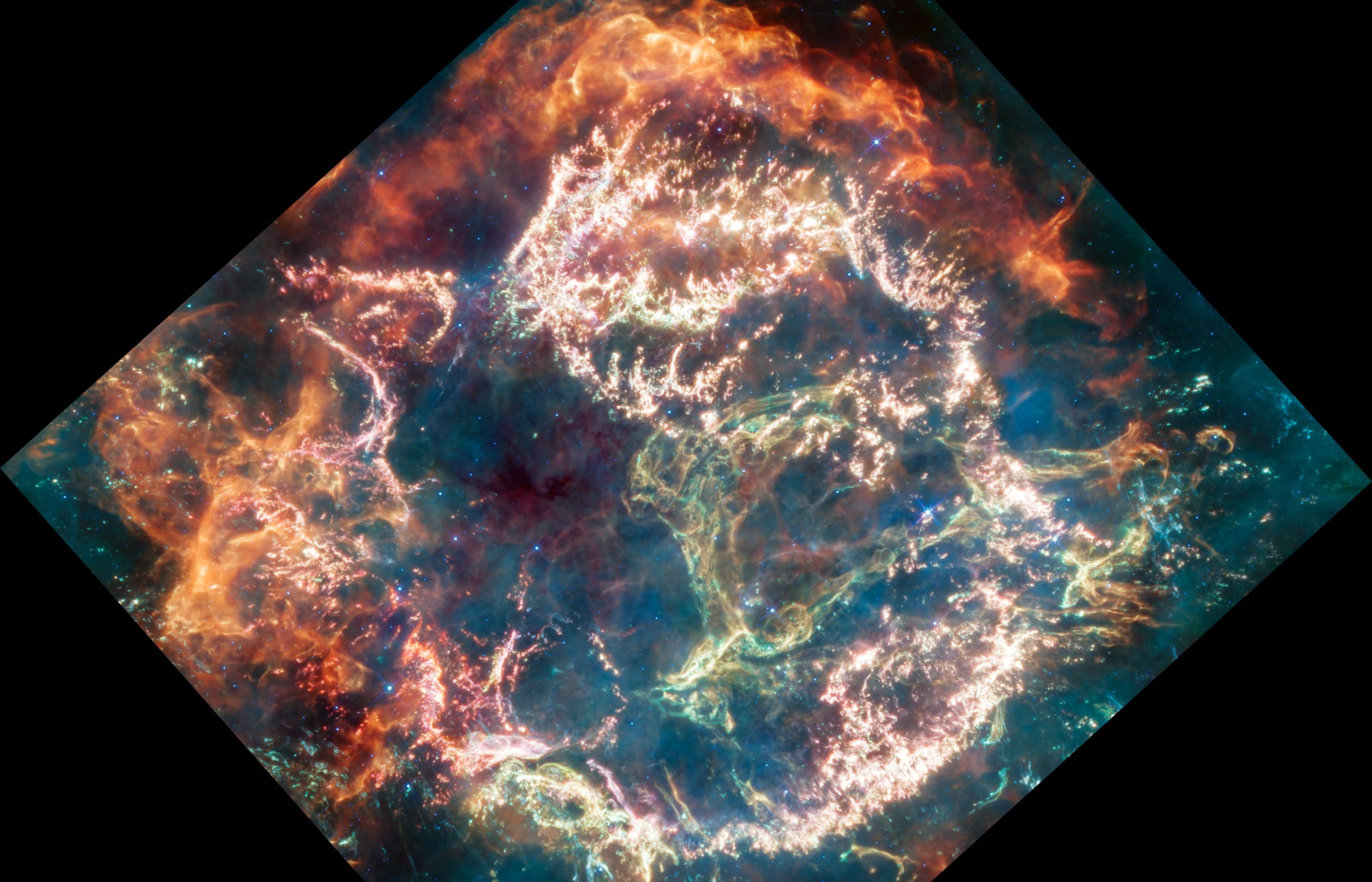
The Green Monster of Space: Unveiling a Supernova Remnant’s Hidden Secrets With Webb
Glowing dust and elements display complex structures that are challenging for scientists to explain. The explosion of a star is a dramatic event, but the remains that the star leaves behind can be even more dramatic. A new mid-infrared image from NASA’s James Webb Space Telescope provides one stunn
scitechdaily.com
High res



cybrguy
Putin is a War Criminal
So apparently the FAA has granted SpaceX permission to launch Starship for it's first attempt at an orbital launch. That is pretty cool and exciting. Launch is scheduled for Monday. Hold on to your seats...

 www.space.com
www.space.com
I know some of you all hate the guy, but this isn't about him. It's about the future of spaceflight.

SpaceX Starship shines on pad ahead of 1st orbital launch (photos)
SpaceX's Starship vehicle gleams in the sunrise over the company's Starbase facility in South Texas, where the vehicle waits ready to make its debut test flight.
I know some of you all hate the guy, but this isn't about him. It's about the future of spaceflight.

